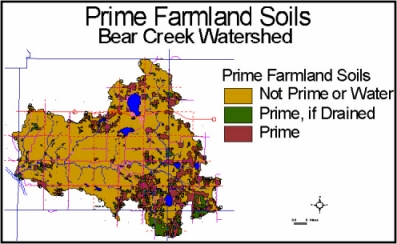Bear Creek Watershed Project - Prime Farmland Soils


Prime farmland, as defined by the U.S. Department of Agriculture, is land that is best suited to food, feed, forage, fiber, and oilseed crops. It may be cultivated land, pasture, woodland, or other land, but it is not urban and built- up land or water areas. The land is either used for food or fiber crops or is available for those crops. The soil qualities, growing season, and moisture supply are those needed for a well managed soil to economically produce a sustained high yield of crops. Prime farmland soils produce the highest yields with minimal inputs of energy and economic resources, and farming it results in the least damage to the environment.
Prime farmland soils have an adequate and dependable supply of moisture from precipitation or irrigation. They have few or no rocks, are permeable to water and air, and have acceptable acidity or alkalinity levels. They are not excessively erodible or saturated with water for long periods and are not frequently flooded during the growing season. The slope ranges mainly from 0 to 6 percent.
The recent trend in land use has been the loss of prime farmland to urbanization. The loss of prime farmland to other uses puts pressure on marginal lands, which generally are more erodible, droughty, less productive, and cannot by easily cultivated.
The data layer shows prime farmland soil, and prime farmland soils, if drained. The "if drained" category include soils that have a seasonally high water table and qualify for prime farmland only in areas where this limitation has been overcome by drainage measures.
